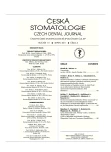Burning Mouth Syndrome – The Most Common Causes of Our Patients
Authors:
S. Kaprálová
Authors‘ workplace:
Klinika zubního lékařství LF UP a FN, Olomouc
Published in:
Česká stomatologie / Praktické zubní lékařství, ročník 111, 2011, 4, s. 78-84
Category:
Original Article – Retrospective Essay
Overview
Oral cavity, including lips and labial mucosa in red, constitutes the environment that is daily exposed to many substances that may have an irritative nature and cause many unpleasant sensations. This state is termed as a “dyny”, in the foreign literature, a term Burning Mouth Syndrome (BMS) is used in addition to local factors may play a role in the overall effects, possibly combination of both. Stomatodynia divided into stomatodynia in the strict sense, it is not possible to identify any of these factors or stomatodynia in a broader sense, where a comprehensive examination of the precipitating factors can explain. Among the local factors evoking oral cavity irritation, we include allergies to dental materials, galvanic stimulation, changes in microbial flora of the mouth, dry mouth caused by above-mentioned factors and/or reaction to used medication. Thus, the emergence of dyny is governed by the overall health of the patient, the above-mentioned drugs, hormonal and metabolic disorders, neuropathy, angiopathy, radiotherapy and chemotherapy.The aim of our study was to find some of these above-mentioned causes, mainly of a local character, and to relieve the patient’s suffering, which can often lead to cancerophobia and often to a substantial reduction of psychological comfort of the patient. In collaboration with the Dermatology Clinic, University Hospital in Olomouc, we searched for possible allergies to dental materials utilizing patch tests, we then monitored other etiopathogenetic factors of stomadynia evaluating detailed examinations.
Key words:
stomatodynia – Burning Mouth Syndrome – allergies to dental materials
Sources
1. Bains, V. K., Loomba, K., Loomba, A., Bains, R.: Mercury sensitisation: review, relevance and a clinical report. Br. Dent. J., roč. 205, 2008, č. 7, s. 373–378.
2. Buchanan, J., Zakrzewska, J.: Burning mouth syndrome. BMJ Clinical Evidence, 2008, 03, s. 1301–1308
3. Corazza, M., Levratti, A., Virgih, A.: Allergic contact cheilitis dus to carvone in toothpastes. Contact Dermatitis, roč. 46, 2002, s. 366–367.
4. Dahlén, G.: Non-odontogenic infections in dentistry. Periodontology 2000, roč. 49, 2009, s. 7–12.
5. Dahlén, G.: Bacterial infections of the oral mucosa. Periodontology 2000, roč. 49, 2009, s. 13–38.
6. De Rossi, S. S., Greenberg, M. S.: Intraoral contact allergy: a literature review and case reports. J. Am. Dent. Assoc., roč. 129, 1998, č. 10, s. 1435–1441.
7. Ditrichová, D., Kaprálová, S., Tichý, M., Tichá, V., Dobešová, J., Justová, E., Eber, M., Pírek, P.: Oral lichenoid lesions and allergy to dental materials. Biomed. Pap. Med. Fac. Univ. Palacky Olomouc Czech Repub., roč. 151, 2007, č. 2, s. 333–339.
8. Dobešová, J., Ditrichová, D., Kaprálová, S., Pírek, P., Eber, M.: Kontaktní alergická cheilitida. Derma, roč. VII, 2007, č. 1, s. 12–16.
9. Fedele, S., Fricchione, G., Porter, S. R., Mignogna, M. D.: Burning mouth syndrome (stomatodynia). QJM, roč. 100, 2007, č. 8, s. 527–530.
10. Grushka, M., Epstein, J. B., Gorsky, M.: Burning mouth syndrome. Am. Fam. Physician, roč. 65, 2002, č. 4, s. 615–622.
11. Hosoki, M., Bando, E., Asaoka, K., Takeuchi, H., Nishigawa, K.: Assessment of allergic hypersenzitivity to dental materials. Biomed. Mater. Eng., roč. 19, 2009, č. 1, s. 53–61.
12. Ivančaková, R., Slezák, R.: Infekce ústní sliznice. Med. pro Praxi, 2006, č. 6, s. 288–290.
13. Jirásková, M.: Dermatovenerologie pro stomatology. 1. vyd., Praha, Professional Publishing, 2001. ISBN 80-86419-07-X.
14. Kalfus, P., Dřízhal, I., Živný, P.: Orální lichen planus a hepatitida C. LKS, roč. 16, 2006, č. 2, s. 18–21.
15. Pallasch, T. J.: Antifungal and antiviral chemotherapy. Periodontology 2000, roč. 28, 2002, s. 240–255.
16. Pinto, A., Stoopler, E. T., DeRossi, S. S., Sollecito, T. P., Popovic, R.: Burning mouth syndrome: a guide for the general practitioner. Gen. Dent., roč. 51, 2003, č. 5, s. 458–461.
17. Poddaná, M., Joska, L., Venclíková, Z.: Vliv koroze na vznik pigmentace měkké tkáně. Čes. Stomat., roč. 107, 2007, č. 1, s. 10–13.
18. Slezák, R., Ryška, A.: Kouření a dutina ústní. 1. vyd., Praha, Havlíček Brain Team, 2006. ISBN 80-903609-6-3.
19. Slezák, R.: Malé ilustrované repetitorium. LKS, roč. 16, 2006, č. 10, s. 31–32.
20. Slezák, R.: Stručná charakteristika rezidentní mikroflóry dutiny ústní. Folia Parodontologica Bohemica, roč. 3, 2007, č. 4, s. 11–17.
21. Slezák, R., Dřízhal, I., Hubková, V., Doležalová, H., Pavlicová, A., Nováková, V., Kopecký, O.: Choroby ústní sliznice v praxi zubního lékaře. LKS, roč. 17, 2007, č. 10, s. 26–28.
22. Stanford, T. W., Rivera-Hidalgo, F.: Oral mucosal lesions caused by infective microorganisms. II. Fungi and parasites. Periodontology 2000, roč. 21, 1999, s. 125–144.
23. Škach, M., Švejda, J., Liška, K.: Onemocnění ústní sliznice. 2. vyd., Praha, Avicenum, 1975.
24. Vavřičková, L., Dostálová, T., Vahalová, D., Šrámková, J.: Koroze dentálních slitin. Prakt. zub. Lék., roč. 55, 2007, č. 5, s. 87–93.
25. Vavřičková, L., Dostálová, T., Vahalová, D.: Dentální slitiny kovů. Část I.: Dělení dentálních slitin, fyzikální a chemické vlastnosti. Čes. Stomat., roč. 108, 2008, č. 2, s. 39–46.
26. www:dentalgentlecare.com/burning_mouth_syndrome.htm.
27. www.mayoclinic.com/health/burning-mouth-syndrome/DS00462.
28. www.nidcr.nih.gov/OralHealth/Topics/Burning/BurningMouthSyndrome.htm.
Labels
Maxillofacial surgery Orthodontics Dental medicineArticle was published in
Czech Dental Journal

2011 Issue 4
- What Effect Can Be Expected from Limosilactobacillus reuteri in Mucositis and Peri-Implantitis?
- The Importance of Limosilactobacillus reuteri in Administration to Diabetics with Gingivitis
Most read in this issue
- Cysts of Mandible and Maxilla. Etiology, Diagnostic Tools and Treatment Possibilities
- Burning Mouth Syndrome – The Most Common Causes of Our Patients
- Dental Erosions
- Evalutation of Antimicrobial Effect of Ozonated Water for Disinfection Dental Impressions
